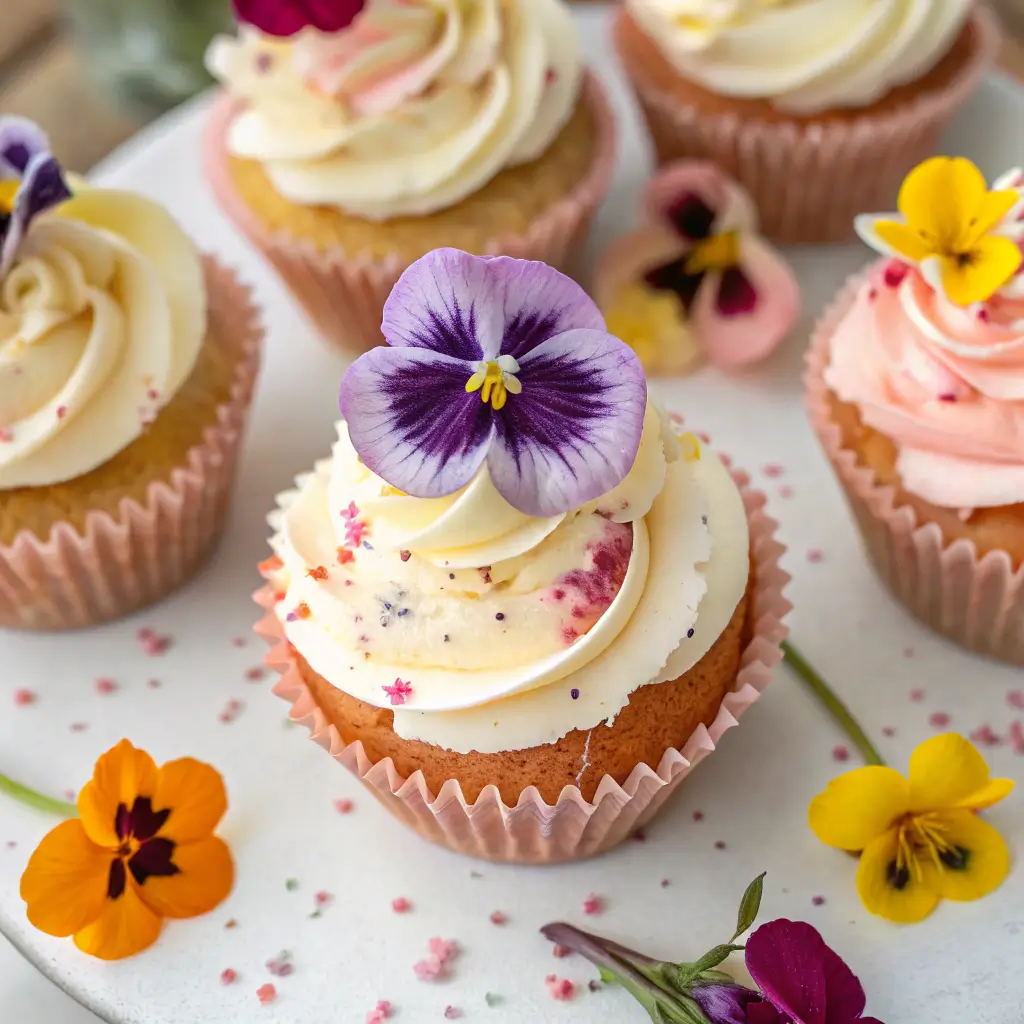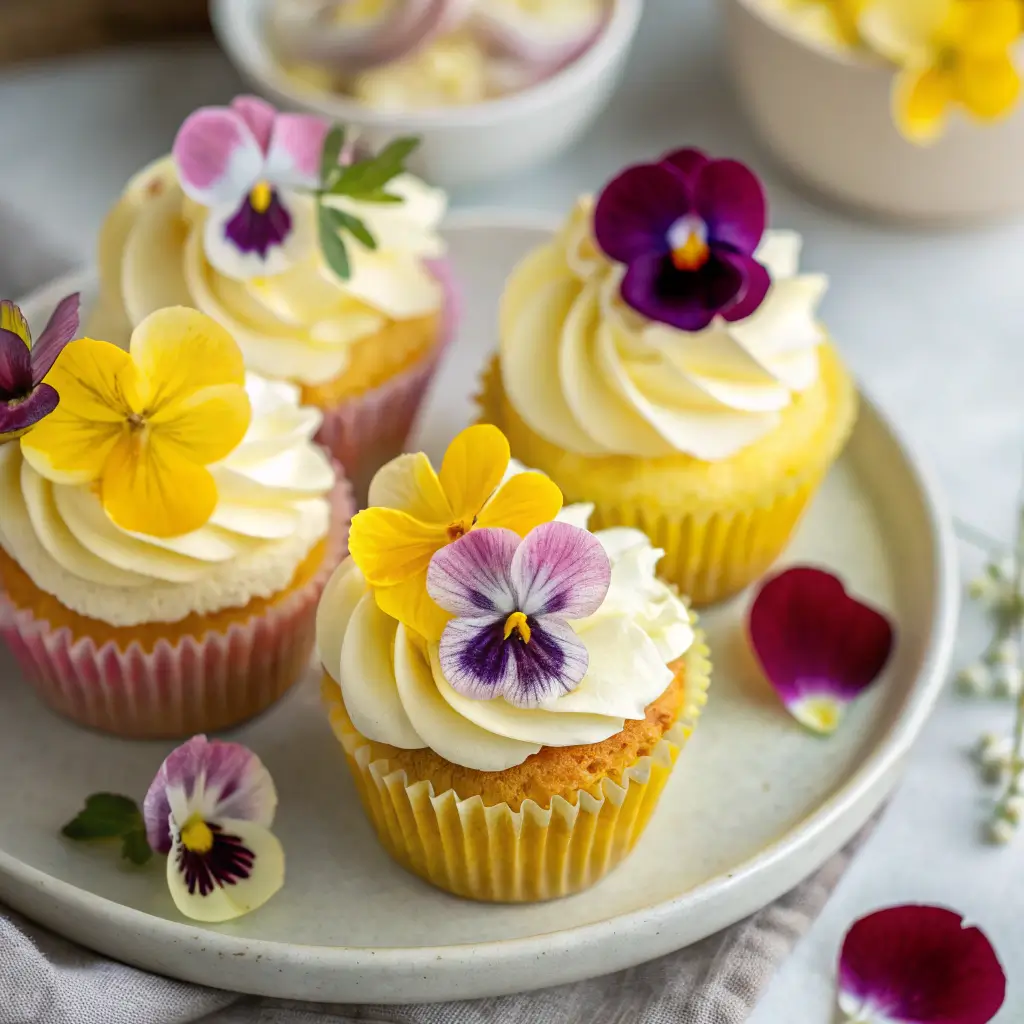Spring Flower Cupcakes with Edible Flowers: A Stunning Seasonal Treat
Introduction
Spring is the season of color, renewal, and freshness—and what better way to celebrate it than with Spring Flower Cupcakes topped with edible flowers? These cupcakes are not only delicious, but also a feast for the eyes. With their light, fluffy base and delicate floral decorations, they’re perfect for Easter brunches, garden parties, bridal showers, or any occasion that calls for something beautiful and unique.
Using edible flowers brings an elegant, nature-inspired touch to classic cupcakes. From pansies and violets to marigolds and nasturtiums, these blossoms aren’t just pretty—they add subtle flavors that complement the sweetness of the cake and frosting. Best of all, decorating with edible flowers is surprisingly easy, making these cupcakes a great project for both novice and experienced bakers.

A Little Background on Edible Flowers
Cooking and baking with edible flowers is not new—it dates back centuries. Ancient Greeks and Romans often used violets, roses, and lavender in both food and medicine. Today, chefs and bakers use flowers to elevate desserts, salads, and drinks with color, aroma, and delicate flavors.
When it comes to cupcakes, edible flowers make them feel instantly seasonal and sophisticated. Choosing flowers that are safe to eat and free from pesticides is essential. Organic edible flowers from farmers’ markets, specialty stores, or your own garden are the best choices.
Why You’ll Love These Cupcakes
- Beautiful presentation – They look like they came straight from a boutique bakery.
- Seasonal and fresh – Perfect for spring celebrations and outdoor gatherings.
- Easy to customize – Choose flowers and frosting flavors to match your theme.
- Unique flavors – Flowers like lavender or pansies add subtle herbal notes.
- Great for special occasions – Ideal for Easter, Mother’s Day, baby showers, and weddings.
Ingredients
For the Cupcakes
- 1 ½ cups (190 g) all-purpose flour
- 1 ½ teaspoons baking powder
- ¼ teaspoon salt
- ½ cup (115 g) unsalted butter, softened
- 1 cup (200 g) granulated sugar
- 2 large eggs, room temperature
- 1 teaspoon vanilla extract
- ½ cup (120 ml) whole milk
For the Buttercream Frosting
- 1 cup (230 g) unsalted butter, softened
- 3 ½ cups (420 g) powdered sugar, sifted
- 2–3 tablespoons heavy cream or milk
- 1 teaspoon vanilla extract
- Optional: 1–2 teaspoons finely ground dried lavender or rose petals for flavor
For Decoration
- 1–2 cups fresh edible flowers (pansies, violas, marigolds, nasturtiums, chamomile blossoms, or rose petals)
- Fresh mint leaves (optional)
Equipment Needed
- Muffin tin
- Cupcake liners
- Electric hand or stand mixer
- Mixing bowls
- Rubber spatula
- Piping bag and tips (optional for frosting)
Step-by-Step Instructions
Step 1: Bake the Cupcakes
- Preheat oven to 350°F (175°C) and line a muffin tin with 12 cupcake liners.
- In a medium bowl, whisk together flour, baking powder, and salt.
- In a large bowl, cream butter and sugar until light and fluffy (about 3 minutes).
- Beat in eggs one at a time, then add vanilla extract.
- Alternate adding dry ingredients and milk, starting and ending with the dry mixture. Mix just until combined.
- Divide batter evenly into cupcake liners.
- Bake for 18–20 minutes, or until a toothpick inserted in the center comes out clean.
- Cool completely before frosting.
Step 2: Make the Buttercream Frosting
- Beat softened butter until creamy.
- Gradually add powdered sugar, one cup at a time, mixing well.
- Add vanilla and 2 tablespoons cream or milk. Beat on high until fluffy. If too stiff, add another tablespoon of liquid.
- For floral flavor, fold in ground dried lavender or rose petals.
Step 3: Frost and Decorate
- Pipe or spread buttercream onto cooled cupcakes.
- Gently press edible flowers into the frosting.
- Use a mix of large and small blossoms for visual variety.
- Optional: add mint leaves for greenery.
Pro Tips for Success
- Use fresh flowers on the day of serving – They wilt quickly once applied.
- Match colors – Use contrasting or complementary flower colors for the best presentation.
- Go light with floral flavors – A little lavender or rose goes a long way.
- Don’t overmix batter – To keep cupcakes tender, stop mixing once ingredients are combined.
- Store carefully – Frosted and decorated cupcakes are best stored in the fridge, uncovered, for 1–2 hours before serving.
Variations & Creative Ideas
- Citrus Blossom Cupcakes – Add lemon zest to the batter and top with candied orange blossoms.
- Herbal Twist – Infuse the frosting with chamomile or mint for a subtle herbal note.
- Chocolate Flower Cupcakes – Swap vanilla batter for chocolate, pairing beautifully with marigolds or pansies.
- Mini Cupcakes – Make bite-sized versions for dessert buffets or tea parties.
- Pressed Flower Topping – Use dried, pressed edible flowers for a unique, artistic look.
Nutritional Highlights
While these are indulgent treats, they have some lighter benefits:
- Edible flowers – Contain antioxidants and phytochemicals.
- Small serving size – Individual cupcakes provide built-in portion control.
- Customizable frosting – You can reduce sugar or use whipped cream for a lighter topping.

Serving Suggestions
- Garden Party – Arrange on a tiered cake stand for a floral centerpiece.
- Bridal or Baby Showers – Coordinate flower colors with the event theme.
- Easter Celebration – Pair with pastel decorations for a festive dessert table.
- Afternoon Tea – Serve alongside scones, finger sandwiches, and herbal teas.
Storage & Make-Ahead Tips
- Cupcakes – Can be baked 1 day ahead and stored at room temperature in an airtight container.
- Frosting – Make up to 3 days ahead; refrigerate and bring to room temperature before using.
- Assembled cupcakes – Best enjoyed the same day flowers are added. Refrigerate leftovers, but note that flowers may wilt.
Frequently Asked Questions
Q: Are all flowers safe to eat?
No, only specific flowers are edible. Safe choices include pansies, violas, nasturtiums, marigolds, chamomile, and rose petals. Avoid flowers treated with pesticides.
Q: Can I use dried flowers?
Yes, dried edible flowers (like lavender or rose) can be incorporated into the frosting or sprinkled as decoration.
Q: Can these be made gluten-free?
Yes, substitute all-purpose flour with a gluten-free flour blend. The texture remains light and fluffy.
Why This Recipe Works
The light, vanilla-scented cupcakes provide the perfect base for creamy buttercream and fresh flowers. The edible blossoms elevate ordinary cupcakes into a visually stunning dessert that tastes as fresh as it looks. By combining simple baking techniques with natural beauty, you create treats that celebrate spring in every bite.
Conclusion
Spring Flower Cupcakes with Edible Flowers are the ultimate dessert for celebrating the season. They’re bright, fresh, and elegant—perfect for impressing guests without complicated techniques. Whether for a garden party, Easter celebration, or simply a joyful afternoon treat, these cupcakes capture the beauty of spring in edible form.
Next time you want to bake something memorable, reach for this recipe. Not only will you create cupcakes that taste amazing, but you’ll also bring the beauty of a spring garden straight to your dessert table.
